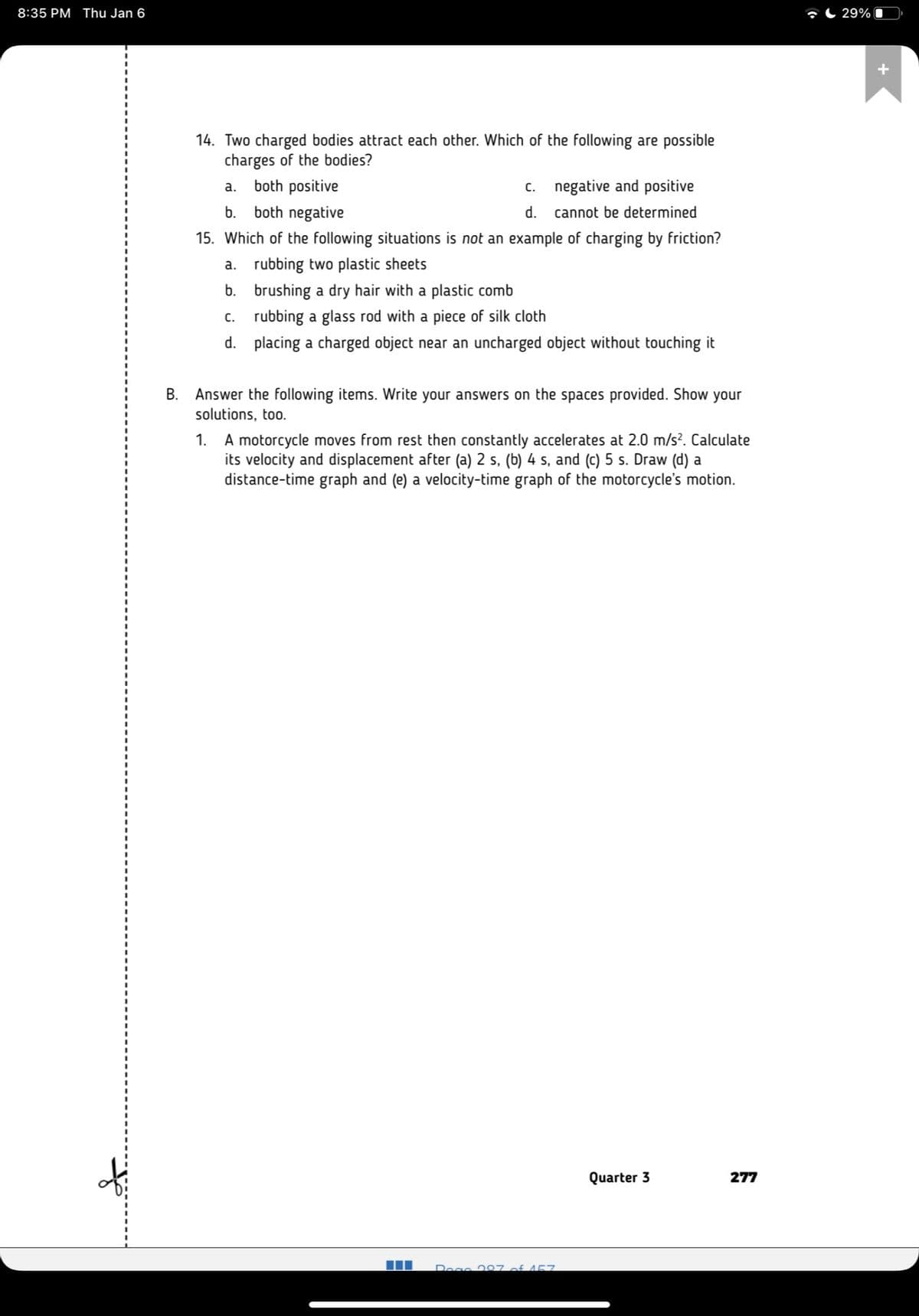14. Two charged bodies attract each other. Which of the following are possible charges of the bodies? both positive c. negative and positive a. b. both negative d. cannot be determined
14. Two charged bodies attract each other. Which of the following are possible charges of the bodies? both positive c. negative and positive a. b. both negative d. cannot be determined
Physics for Scientists and Engineers, Technology Update (No access codes included)
9th Edition
ISBN:9781305116399
Author:Raymond A. Serway, John W. Jewett
Publisher:Raymond A. Serway, John W. Jewett
Chapter24: Gauss’s Law
Section: Chapter Questions
Problem 24.9CQ: A common demonstration involves charging a rubber balloon, which is an insulator, by rubbing it on...
Related questions
Question
Answer number 14-15 and also the problem solving on letter B with full solution.

Transcribed Image Text:8:35 PM Thu Jan 6
C 29% I
14. Two charged bodies attract each other. Which of the following are possible
charges of the bodies?
both positive
c. negative and positive
а.
b.
both negative
d.
cannot be determined
15. Which of the following situations is not an example of charging by friction?
a. rubbing two plastic sheets
b. brushing a dry hair with a plastic comb
c. rubbing a glass rod with a piece of silk cloth
d. placing a charged object near an uncharged object without touching it
Answer the following items. Write your answers on the spaces provided. Show your
solutions, too.
В.
1. A motorcycle moves from rest then constantly accelerates at 2.0 m/s?. Calculate
its velocity and displacement after (a) 2 s, (b) 4 s, and (c) 5 s. Draw (d) a
distance-time graph and (e) a velocity-time graph of the motorcycle's motion.
Quarter 3
277
Dego 207 of 457.
Expert Solution
This question has been solved!
Explore an expertly crafted, step-by-step solution for a thorough understanding of key concepts.
Step by step
Solved in 2 steps with 1 images

Knowledge Booster
Learn more about
Need a deep-dive on the concept behind this application? Look no further. Learn more about this topic, physics and related others by exploring similar questions and additional content below.Recommended textbooks for you

Physics for Scientists and Engineers, Technology …
Physics
ISBN:
9781305116399
Author:
Raymond A. Serway, John W. Jewett
Publisher:
Cengage Learning

College Physics
Physics
ISBN:
9781938168000
Author:
Paul Peter Urone, Roger Hinrichs
Publisher:
OpenStax College


Physics for Scientists and Engineers, Technology …
Physics
ISBN:
9781305116399
Author:
Raymond A. Serway, John W. Jewett
Publisher:
Cengage Learning

College Physics
Physics
ISBN:
9781938168000
Author:
Paul Peter Urone, Roger Hinrichs
Publisher:
OpenStax College


College Physics
Physics
ISBN:
9781285737027
Author:
Raymond A. Serway, Chris Vuille
Publisher:
Cengage Learning

Principles of Physics: A Calculus-Based Text
Physics
ISBN:
9781133104261
Author:
Raymond A. Serway, John W. Jewett
Publisher:
Cengage Learning

Physics for Scientists and Engineers with Modern …
Physics
ISBN:
9781337553292
Author:
Raymond A. Serway, John W. Jewett
Publisher:
Cengage Learning